Related Research Articles
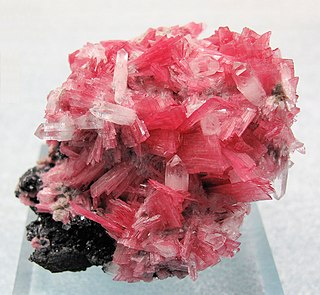
Rhodonite is a manganese inosilicate, with the formula (Mn, Fe, Mg, Ca)SiO3, and member of the pyroxenoid group of minerals, crystallizing in the triclinic system. It commonly occurs as cleavable to compact masses with a rose-red color (its name comes from Ancient Greek ῥόδον (rhódon) 'rose'), often tending to brown due to surface oxidation. The rose-red hue is caused by the manganese cation (Mn2+).

Hausmannite is a complex oxide, or a mixed oxide, of manganese containing both di- and tri-valent manganese. Its chemical formula can be represented as MnIIMnIII2O4, or more simply noted as MnO·Mn2O3, or Mn3O4, as commonly done for magnetite, the corresponding iron oxide. It belongs to the spinel group and forms tetragonal crystals. Hausmannite is a brown to black metallic mineral with Mohs hardness of 5.5 and a specific gravity of 4.8.
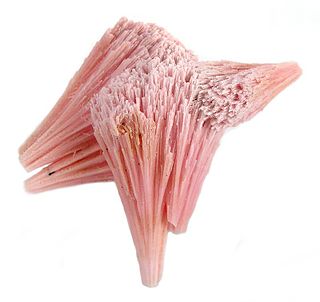
Kutnohorite is a rare calcium manganese carbonate mineral with magnesium and iron that is a member of the dolomite group. It forms a series with dolomite, and with ankerite. The end member formula is CaMn2+(CO3)2, but Mg2+ and Fe2+ commonly substitute for Mn2+, with the manganese content varying from 38% to 84%, so the formula Ca(Mn2+,Mg,Fe2+)(CO3)2 better represents the species. It was named by Professor Bukowsky in 1901 after the type locality of Kutná Hora, Bohemia, in the Czech Republic. It was originally spelt "kutnahorite" but "kutnohorite" is the current IMA-approved spelling.
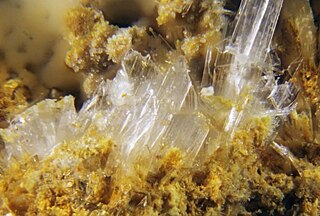
Gunningite is one of the minerals in the Kieserite group, with the chemical formula (Zn,Mn2+)SO4·H2O. Its name honours Henry Cecil Gunning (1901–1991) of the Geological Survey of Canada and a professor at the University of British Columbia.
Jarosewichite is a rare manganese arsenate mineral with formula: Mn2+3Mn3+(AsO4)(OH)6. It was first described in Franklin, New Jersey which is its only reported occurrence. Its chemical composition and structure are similar to chlorophoenicite. This mineral is orthorhombic with 2/m2/m2/m point group. Its crystals are prismatic or barrel-shaped. The color of jarosewichite is dark red to black. It has subvitreous luster of fracture surfaces and reddish-orange streak. This mineral occurs with flinkite, franklinite, andradite and cahnite.

Tienshanite, named for the Tian Shan Range in Mongolia, is a rare borosilicate mineral, though rock-forming in some parts of its original locality at the Dara-i-Pioz Glacier in Tajikistan. Its formula is extremely complex: KNa3(Na,K,[])6(Ca,Y,RE)2Ba6(Mn2+,Fe2+,Zn,Ti)6(Ti,Nb)6Si36B12O114[O5.5(OH,F)3.5]F2.

Zemannite is a very rare oxide mineral with the chemical formula Mg0.5ZnFe3+[TeO3]3·4.5H2O. It crystallizes in the hexagonal crystal system and forms small prismatic brown crystals. Because of the rarity and small crystal size, zemannite has no applications and serves as a collector's item.
Sewardite is a rare arsenate mineral with formula of CaFe3+2(AsO4)2(OH)2. Sewardite was discovered in 1982 and named for the mineralogist, Terry M. Seward (born 1940), a professor of geochemistry in Zürich, Switzerland.

Eveite is a manganese arsenate mineral in the olivenite group. Its chemical formula is Mn2AsO4OH. It is found only in Långban, Filipstad, Värmland, Sweden and at the Sterling Mine in New Jersey, United States. It is a dimorph of sarkinite and is isostructural with adamite. The name, for the biblical "Eve", comes from its structural similarities to adamite and is also a reference to its apple-green color. It can also be pale yellow. Eveite is an orthorhombic mineral, which means it has three crystallographic axes of unequal lengths which are at 90° to one another.
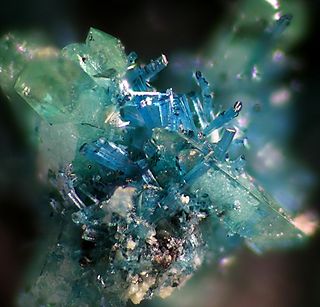
Keyite is a mineral with the chemical formula Cu2+3Zn4Cd2(AsO4)6 · 2H2O. The name comes from Charles Locke Key, an American mineral dealer who furnished its first specimens. Keyite is monoclinic-prismatic, meaning its crystal form has three unequal axes, two of which have 90° angles between them and one with an angle less than 90°. Keyite belongs to the biaxial optical class, meaning it has more than one axis of anisotropy, in which light travels with zero birefringence, and three indices of refraction, nα = 1.800, nβ, and nγ = 1.870. Being a very rare cadmium copper arsenate, keyite is only found in Tsumeb, Namibia in the Tsumeb mine, a world-famous copper mine known for its abundance of rare and unusual minerals.
Penikisite was discovered by Alan Kulan and Gunar Penikis near Rapid Creek, Yukon Territory. The mineral is a member of the bjarebyite group along with kulanite, ideally BaFe2+2Al2(PO4)3(OH)3, and bjarebyite, ideally BaMn2+2Al2(PO4)3(OH)3. It is among several new minerals that have been discovered in the Rapid Creek and Big Fish areas of Yukon Territory. Kulanite is similar in many ways to penikisite in appearance and properties. The chemical formula for penikisite is Ba(Mg,Fe,Ca)Al2(PO4)2(OH)3. It has a hardness of about 4 and a density of 3.79 g/cm3. Penikisite is unique among the bjarebyite group in being monoclinic and has a biaxial optical class. It comes in shades of blue and green and, when rubbed on a streak plate, is pale green to white in color. Although penikisite and kulanite both range from blue to green, penikisite zones are easily distinguishable from kulanite zones in kulanite-penikisite crystals because they are lighter than the darker kulanite in color. Penikisite is a phosphate and is different from kulanite in that it is a magnesium-rich phosphate whereas kulanite is an iron-rich phosphate.

Shigaite is a mineral with formula NaAl3(Mn2+)6(SO4)2(OH)18·12H2O that typically occurs as small, hexagonal crystals or thin coatings. It is named for Shiga Prefecture, Japan, where it was discovered in 1985. The formula was significantly revised in 1996, identifying sodium as a previously unknown constituent.
Arsenoclasite (originally arsenoklasite) is a red or dark orange brown mineral with formula Mn5(AsO4)2(OH)4. The name comes from the Greek words αρσενικόν (for arsenic) and κλάσις (for cleavage), as arsenoclasite contains arsenic and has perfect cleavage. The mineral was discovered in 1931 in Långban, Sweden.
Falsterite is a rare phosphate mineral with the formula Ca2MgMn2+2(Fe2+0.5Fe3+0.5)4Zn4(PO4)8(OH)4(H2O)14. It is a pegmatitic mineral, related to the currently approved mineral ferraioloite.
Filipstadite is a very rare mineral of the spinel group, with the formula (Mn,Mg)(Sb5+0.5Fe3+0.5)O4. It is isometric, although it was previously though to be orthorhombic. When compared to a typical spinel, both the octahedral and tetrahedral sites are split due to cation ordering. Filipstadite is chemically close to melanostibite. The mineral comes from Långban, Sweden, a manganese skarn deposit famous for many rare minerals.
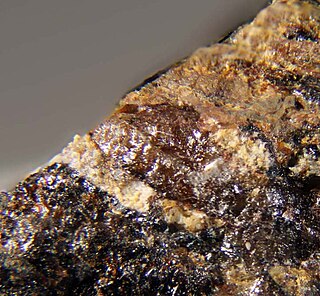
Jinshajiangite is a rare silicate mineral named after the Jinshajiang river in China. Its currently accepted formula is BaNaFe4Ti2(Si2O7)2O2(OH)2F. It gives a name of the jinshajiangite group. The mineral is associated with alkaline rocks. In jinshajiangite, there is a potassium-to-barium, calcium-to-sodium, manganese-to-iron and iron-to-titanium diadochy substitution. Jinshajiangite is the iron-analogue of surkhobite and perraultite. It is chemically related to bafertisite, cámaraite and emmerichite. Its structure is related to that of bafertisite. Jinshajiangite is a titanosilicate with heteropolyhedral HOH layers, where the H-layer is a mixed tetrahedral-octahedral layer, and the O-layer is simply octahedral.
Maneckiite is a rare phosphate mineral with the formula(Na[])Ca2Fe2+2(Fe3+Mg)Mn2(PO4)6•2H2O. It was found in Michałkowa, Góry Sowie Block, Lower Silesia, Poland.
Wiklundite is a rare and complex arsenite-silicate mineral with the chemical formula Pb2(Mn2+,Zn)3(Fe3+,Mn2+)2(Mn2+,Mg)19(As3+O3)2(Si,As5+O4)6(OH)18Cl6. The mineral characterizes in a large c unit cell parameter. It was found in Långban, Sweden - a home for many rare and exotic minerals.

Khinite is a rare tellurate mineral with the formula Pb2+Cu2+3TeO6(OH)2 It crystallizes in the orthorhombic system and has a bottle-green colour. It is often found as dipyramidal, curved or corroded crystals no more than 0.15 mm in size. The tetragonal dimorph of khinite is called parakhinite.

An arsenate arsenite is a chemical compound or salt that contains arsenate and arsenite anions (AsO33- and AsO43-). These are mixed anion compounds or mixed valence compounds. Some have third anions. Most known substances are minerals, but a few artificial arsenate arsenite compounds have been made. Many of the minerals are in the Hematolite Group.
References
- ↑ Warr, L.N. (2021). "IMA-CNMNC approved mineral symbols". Mineralogical Magazine. 85 (3): 291–320. Bibcode:2021MinM...85..291W. doi: 10.1180/mgm.2021.43 . S2CID 235729616.
- ↑ Roberts, A.C., Grice, J.D., Cooper, M.A., Hawthorne, F.C., and Feinglos, M.N., 2000. A new Zn-bearing hematolite-like mineral from Långban, Värmland, Sweden. Mineralogical Record 31(3), 253-256
- ↑ "Arakiite: Arakiite mineral information and data". Mindat.org. Retrieved 2016-03-04.
- ↑ Cooper, M.A.; Hawthorne, F.C. (1999). "The effect of differences in coordination on ordering of polyvalent cations in close-packed structures: The crystal structure of arakiite and comparison with hematolite". The Canadian Mineralogist. 37: 1471–1482.